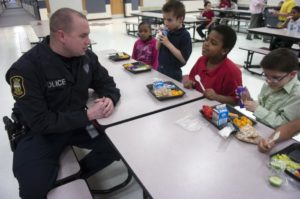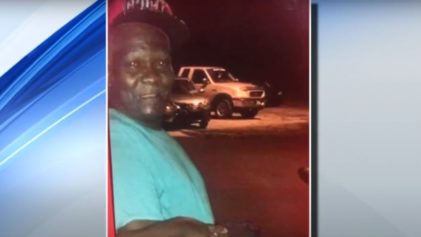
Photo: Kelli Cardinal Lima Police officer Nate Garlock talks with students during their lunch period at Freedom Elementary School in Lima.
The one factor that best determines whether a school will assume greater security measures is not crime or violence. It is the presence of Black children. A new study from two academics found that even when controlling for factors such as school misconduct and neighborhood crime, the mere existence of African-American children in a school makes it more likely the institution will beef up its security. According to the study, there were greater racial disparities in arrests and suspensions of students where there are police officers or other security measures, as reported in Talking Points Memo.
The researchers, Tim Servoss, a professor of psychology at Canisius College in New York, and Jeremy Finn, a professor of education at the State University of New York at Buffalo, examined a sample of 70 high schools based on three national surveys. At least one part-time police officer was present in three-quarters of the schools. Further, of the 57 percent of schools that employed an officer, there were no arrests, suggesting to the authors that the mere presence of cops is not necessarily bad for a school.
“However, the proportion of African-American students was a significant predictor of security even when controlling for the same background characteristics and crime and misconduct within the school,” the authors wrote. “These results suggest that the implementation of security measures are at least partially based on the perceived threat of the African-American student population rather than any objective dangers within (crime or misconduct), or in the neighborhood (neighborhood crime) surrounding the school.”
The study found that crime and misconduct helped determine whether a school would rely on drug testing, dog sniffs, security guards or police, and other measures, which in turn increase the likelihood of Black students being suspended compared to their white peers. With these security measures, Blacks were three times as likely to be suspended as whites, but without them, African-American students were only twice as likely. Even after accounting for factors such as socioeconomic levels, school size, racial composition and whether the city is located in an urban area, these glaring discrepancies remain.
Meanwhile, with regard to student arrests, the racial divide was even more pronounced with the presence of police in schools. The professors concluded that in the typical school without a law enforcement presence, the disparities in arrests across racial lines was insignificant, with Black children arrested 1.3 times more often than their white peers. Yet, went police were in the school, Black students were 2.2 times as likely than white students to go to the police station or jail.
“To the extent that police in schools may contribute to the disproportionate arrest of African-American students, the use and/or role of police in schools should require careful reexamination,” said the authors.
The researchers plan to present their findings at the American Educational Research Association conference in Washington, DC in April, 2016. The academics have collaborated on other studies regarding school security measures, misbehavior, suspensions and race and gender. In past studies, they have found that when one or more police officers are present in a school, the chances that the school will have a higher number of arrests is increased by a factor of three. Prior research also revealed that Black and Latino students were suspended at higher rates than whites, typically not due to different levels of misbehavior. Further, Black males were suspended at ever increasing rates as school size increased, and most Black students attended schools with enhanced levels of security.
This latest study is timely, given the attention now paid to school resource officers in light of the assault and arrest of Shakara–a black girl at Spring Valley High School in Columbia, South Carolina—by Ben Fields, a white deputy sheriff who served as a school resource officer. Such incidents have placed greater scrutiny on the potential harm to students that may come from the presence of police in their learning environment, as well as the role of racial stereotyping and bias in the criminalization and disciplining of Black children. Nationwide, and particularly in the South, the disproportionate targeting of Black students for expulsions, suspensions and other forms of punishment is dramatic, and a key factor in the ominous school-to-prison pipeline.


